#splasher
Newsies blood type masterpost
Jack: B+
Davey: A-
Crutchie: B+
Race: O+
Spot: A-
Romeo: B-
Blink: AB+
Albert: O-
Mush: A+
Smalls: A+
Skittery: B+
Specs: B-
Finch: O-
Henry: AB+
Les: A-
Tommy boy: A+
Elmer: A+
Sniper: B-
Mike: O+
Ike: O+
Jojo: A-
Buttons: AB+
Boots: B+
Pie-eater: A-
Splasher: AB-
Bunsen: B+
Blummets: A-
Coffee bean: B+
York (I thought this one was just an oc but someone suggested it so…): B-
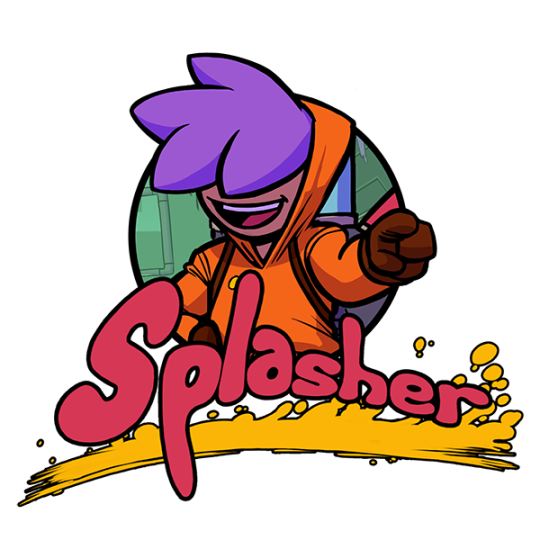
Welcome to a new interview series on PlatformerPower which focuses on people who create platformers! So without further ado here is the interview with Romain Claude (@clauclaudr) who talks about Splasher (A fast paced precision platformer with paintgun mechanics)

Release: Sep 2017 (Switch, PS4, XB1) | Feb 2017 (PC)
[A list of all interviews can be found on the interviews page. Moreover in case you are interested in articles and videos about platformer design consider to check out this list over here]
1. Hi Romain, could you briefly introduce yourself?
I’m Romain Claude, a 32 years old game developer. I discovered video games with Super Mario Bros on the NES when I was around 7 and well, it kind of influenced me a lot …
From that day I developed a strong passion for video games, and not only platformers even if it’s one of my favorite types. When I grew up I needed to figure out how to make my own video games. So I began with programming in high school, learning alone by copy pasting and modifying code from C++ books. To be honest this was not very efficient so after high school I decided to attend real courses. I did a computer science degree for 2 years, before entering a game design school called Supinfogame in Valenciennes (France) for another 2 years. During these 4 years I’ve worked on a lot of small personal projects, demos and stuff (such as developing 2D/3D game engines and level editors). All of this design + tech background led me to get hired as a game designer by Ubisoft Montpellier in 2008. Since, I continue to make games for a living.
A part from that, when I have time for something else, I’m a normal person who likes normal persons things such as drinking with pals, swimming, and going to movies. Oh and some people say I’m ginger.
But I’m not.
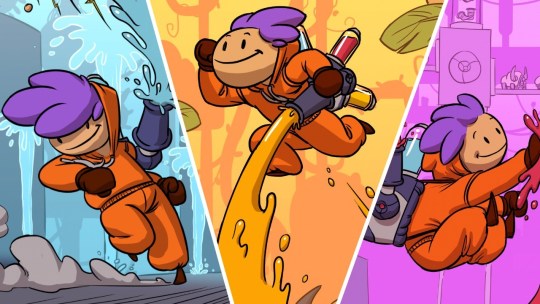
2. What is the background story (and inspirations) of Splasher … how did it come to the game?
The project officially started at the end of 2013, a year after I left Ubisoft during Rayman Legends’ production in 2012. Short story : They wanted me to stay and I have to say it was a cool project, but I was tired of making “AAA” games (even smallest ones like the Raymans). We were not working hard all the time but each time it happened, I was even more frustrated to give so much of my daily life to someone else’s game. Working a lot isn’t a problem for me at all, as far as I can see that it is worth the sacrifice. A 100 hours week once in a while isn’t a big deal as far as my mental and physical health are good, and as far as the result is valuable for me. But in a big company like Ubisoft, it was not the case despite all the positive aspects, and I had this will of becoming indie since a little while then. So when my contract ended and was about to be renewed for a permanent one, it was the right moment to quit the company.
After a couple of experimentations with the XNA framework, I came to the point that making my own engine wasn’t a good idea, and most of all I had no precise “game idea”. Actually I just wanted to use my expertise in 2D platformers (as a player but also a developer) to make a good one my own way, and thus release a first game as an indie. So I was seeking for a cool idea, and the right tech to do it.A friend of mine, Richard Vatinel, who was a classmate in Supinfogame, had made alone in 2011 a small game called One Eye Adventure, which was a Metroidvania with platforming and shooting. Richard is mostly an artist, not a programmer, so he has used Construct to make the game. I liked his game and I was ready to maybe retake it from scratch and make it bigger, cooler, juicier … in one word: “sellable”. I was also wanting to work with him since a long time, so it was a good reason to do that, with this base intention that talked to both of us. On my side I decided to give the Unity Engine a try, so I started alone for the first 2 months, digging tutorials and trying to reproduce a “Meat Boy” feeling in a 2D platformer prototype, and mix that with some shooting gameplay (Super Crate Box was an inspiration at the time). I came up with a first demo in September 2013, that you can find on Itch.io if you are curious to check it out : https://clauclaudr.itch.io/super-meat-guns.

(Super Meat Guns - Prototype)
This demo didn’t even have a visual for the main character nor sound and music. But most of all, despite some potential, it was missing something “unique” in the gameplay. As a developer I personally prefer makings games that are trying to innovate at least a bit in the gameplay mechanics. So even if the game first looks classical, to have my “approval” it needs to feature at least one core mechanic that is truly unique in this type of game. Discussing with Richard about this one day, we thought : “why not making something out of this splatter system we have in this demo ? For now it is just esthetic but let try making it interactive, just to see how it goes”. Of course I immediately remembered Portal 2 with its painting mechanics, and making a 2D version of it sounded like a good call.
And it was.
After 2 additional months of prototyping and decision making, in January 2014 we had our full game idea. Then we started to work more seriously on the art direction, and especially the main character. We also made a public demo to start playtesting the game, and we showcased this demo for the first time in May 2014 at a French arcade gaming festival called Stunfest.
I have also put this first demo on Itch.io by the way : https://clauclaudr.itch.io/splasher-original-prototype.

(Splasher - Prototype)
3. How many people worked on Splasher and how long was the game in development?
A total of 5 people were in the dev-team of the main game for the initial PC release.
Most of the time we were 2 people working every week day on the game (Richard and I), and 3 other ones joined the team later to work part time on music and sound (Aymeric Schwartz/ David Boitier), but also QA and Playtests’ Coordination (Joffrey Babilotte).In 2016, 4 Speedrunners from a well-known collective in France called Nerd Entertainment System also helped for designing our speedrun modes.
Then in 2017 Midgard Studio, a video game studio based in Nîmes (France) was in charge of the consoles’ ports. I also have to mention that we have a publisher, so even for a small indie game, the number of people involved is not so small in the end …
About duration : Consoles’ ports included, Richard and I have worked around 40 months on the game. Yep, that’s a bit long :D.

4. What’s your process for designing and implementing new abilities and gameplay features for
Splasher? (eg: Program a prototype first using placeholder art, sketch out scenarios on paper, etc.)
You have a part of the answer in question 2’s answer, but this is actually not specific to Splasher.
When I work on a game idea, most of the time there is basically NO IDEA. Just random intentions such as these random examples I just made up : “why not making something cool out of joint physics ?”, “why not make a mashup of genre A and genre B” ?, “why not use shaders to make cool interactive things happen when sounds play ?” …
For me, it always starts with a mix between a technical breakthrough AND at least what I call a “toy” intention. A toy is something you can interact with and have fun with, but is not a game on its own. So It is always very blurry at the beginning and that is why I qualify my process an “empiric process”. I need to experiment intentions and observe/play the results, in order to know exactly what I’m doing and what I want to do next. Until I get a full game idea.My approach is a lot more “functional” rather than art or scenario oriented. I’m not saying other approaches are bad, but for sure interactivity is the language of video games. It is what makes them a genuine form of art, because it has its OWN language. You can express things that can’t exist in other forms of art, and because I think Art is a way to say something to the world, a video game is an art on its own thanks to interactivity. It’s not a movie, not a anime, not a book … it’s a game. So of course you can have the approach you want when you develop the game, if in the end the interactivity is compelling: that’s totally fine. But personally I see gameplay as a major concern in my process.
First I prototype a lot, with no art but with placeholder-art (rough / temporary visuals and sounds) that gives an INTENTION. It’s important to have an intention for EVERY aspect of the game, the earliest possible in the process (gameplay, visual, sound, music, and even marketing if you feel inspired). It’s also important to notice that the full “game feel” won’t be there until you have everything setup properly, from code to animation and sounds. You even have cases for which you need to have art almost from the beginning. Animation is a good example of that, because for the main character in an action game, you can have the best code in the world, it’s animation that makes the difference.
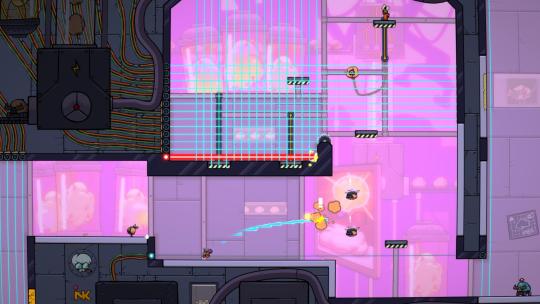
5. What went right/wrong during development of Splasher ?
We had a hard time to organize ourselves with Richard, especially the first year. We are not living in the same town (Montpellier in the south for me, and Rennes for Richard, 10 hours by car in the north). Even if it’s totally OK to work with internet from different places, not having at least “roughly” the same working hours unease the coordination. I was often working by night and him early in the morning. On top of that, and it’s fully understandable, Richard had work-for-hire to do (mainly as a teacher in different schools) as well as personal art stuff to work on, so he often had to delay his work on Splasher for higher priorities.
Both of us were unpaid before the release and so we were living on our own savings. The consequence is that Splasher was not always the priority, especially for Richard. Personally I had this opportunity to be freshly unemployed in France, so I got money from this “status” during almost 3 years, and Richard did various paid jobs in parallel. The right thing is that we were very good friends and despite the obstacles, despite the difficulties we have been through, and despite the tensions we had to deal with sometimes, we are still very good friends today.
In the end I can tell that one of the main drawback was also one of the biggest asset: working without budget with a very good friend, talented artist, very dedicated to the project and most of all someone who trusts you and someone you trust until the end. With no money involved during 40 months, I can tell this is a rare situation. In most cases it doesn’t last that long and/or it ends badly.
Cool thing : Our 3 other part time team mates Aymeric, David and Joffrey were also friends and dedicated people. Thanks to them we managed to reach a very satisfying level of quality we would never had obtained with just the two of us. From Music to bug tracking, they brought the fresh air and the help we needed to finish this game.
I mentioned the speedrun guys a bit earlier in this interview, and it’s important to note that on top of their design expertise they also helped a lot improving our communication in order to reach the speedrun community. So this extra help wasn’t only welcome to polish the gameplay, but it was also a great opportunity for giving the game more visibility at the release. The game was even played at the 2017 SGDQ, which is one of the coolest consequences of this collaboration.
We are very proud of what we have made all together. Of course we are also a bit disappointed by the lack of commercial success (less than 20k copies, consoles included), but the reception by the press and the players have been damn good, especially in France. It’s a small country but if you can at least have that, it’s a good start for future games. We also had a very good reception each time we were attending festivals during the development. The good thing about it is that we knew almost from the beginning we were going to have an audience for our game. Maybe not that big, but a genuine fan base for sure, and it helps to maintain the motivation.Oh, and the consoles ports were a not-so-useful pain in the ass …
My advice : Start by releasing your game on Steam, see how it goes, and if it sells well and want a console, maybe consider making a Switch version. The PS4 and Xbox1 are only worth it if the game is fully supported (marketing included) by the constructor and/or if the game is already a big hit on other
platforms.
Last funny mix between joy and difficulty : Richard’s son Robin is born in 2016 during production, so this new parameter added a layer of complexity for him ahahah. Maybe you have noticed that little baby head at the end of the game credits …
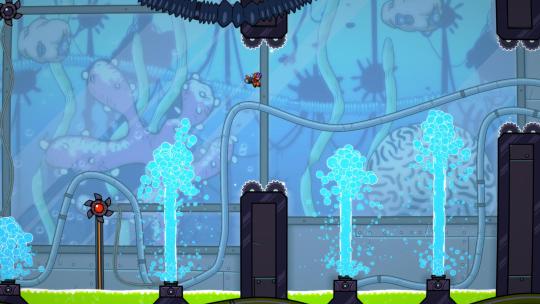
6. Did you do have any big design changes while developing Splasher, if yes, why?
Regarding the main concept it was always a “moving forward” trip, with few major re-orientations.
The only exception is that initially Richard suggested the game to be more puzzle oriented, and back then we did a lot of prototypes following different “puzzle-ish” ideas (like a fire propagation system …
yep, our hero was supposed to be a fireman back in 2013), I was never really convinced. So we ended up with an action game with “fast-paced puzzles”, or let say LD situations that are not 100% no brain, but that you can solve with a fast-paced solution (“unstick that and catch it”, “make this bounce”, “make this wheel turn to open that door while running” …).
A part from this, design changes happened all the time for smaller things and details. It’s a necessary thing for making the game better and better. So balancing the gameplay, finding the right look for the hero, changing the order of some levels to make the difficulty progression more fair, are examples of
what involved changes at different “reasonable” scales, particularly during the conception / pre-production phase, but also after.

7. How long do you actively spend making and tweaking the raw mechanics of a platformer?
Short answer : The whole life of the development process !
Tweaking the core mechanics, tweaking the “game feel” as we call it sometimes, truly is a never ending quest. For instance on Splasher I was continuing on refining the smoothing of the camera transitions between areas, 1 week before the release on Steam …
This is a highly approximate estimation of the time you spend on tweaking the raw mechanics, if you are a designer/programmer :
- Design phase : 80 to 90%
- Pre-production : 60 to 70%
- Production :30 to 40%
- Post release : 0 to 100% depending on players feedback and depending on if tweaking such things it’s acceptable or not after the release. (eg. competitive games have beta phases for that, until being ready for the full release).
8. How do you make a platformer feel good? How do you overcome the challenges that come along
with making a platformer to make it feel satisfying and fun to play? (eg: jump arcs, gravity etc.)
To be excellent a platformer needs an excellent navigation flow. Because a bit like racing games, a platformer is all about NAVIGATION.
The more you give control over the navigation aspects, the more the player will feel the flow and basically the more he will feel good while playing the game. Subtle control given to the player over acceleration, braking, height of jump, steering in air, are some of the things you need to consider if you want a nice flow. All of this will be the root of the level design that will come up in order to create interesting challenges.
There is also a certain design and programming challenge in developing a CAMERA system that is flexible enough to be both very smooth and customizable in order to always frame the right thing, with the right distance and the right offset (and thus make the best out of your level design situations). Actually, the crucial things is to work on your controls and your camera system hand in hand with the level designer(s). Let basically say that you have to make your researches on these 3 subjects at the same time, whether you do all of that by yourself or with different people. Spoiler : being at least a team of 2 working on that is a major advantage, because alone you quickly suffer from a lack of hindsight.
ANIMATION is also a key aspect for making the game feel good. Especially the animation of your main character, because it will give your controller system all its juiciness once in action. This aspect is quite critical to really enjoy the flow and makes the player think he’s doing impressively cool moves with its avatar. One of the best examples are the Assassins Creed games or the recent Spider-Man by Insomniac Games that just blows your mind in terms of character controller’s animation.
Last but not least : PLAYTESTS. The more people (not working on the game) will try it, and the more you are listening to their feedback, the more the game will be good and have a chance of : 1/ making you proud of it, 2/ pleasing its audience, 3/ selling. Of course, playtesters’ feedback need to be sorted and
intelligently included in the design process (eg. don’t change the whole game after a negative playtest, but make it better).
Tons of playtests are actually mandatory for making any type of game good ;)

9. Are there any tricks you’ve deployed that aid the platforming in unusual ways? (eg: giving a few
extra seconds when walking off a ledge where you can still jump etc.)
Giving extra milliseconds to jump after walking of a ledge is indeed a classic one.
You also have this common trick to allow the player to press jump a bit before landing, in order to avoid this bad “broken jump” feeling when you want to jump immediately at landing, but you press jump a couple of frames too early before reaching the ground.
Then for me, most of the time it’s all about “snapping tricks”, meaning : giving spatial margins to the things that can be triggered by the player. The more you want to assist, the more you will snap interactions. For example it can be snapping the cursor on a target when you aim at a point of interest. It can be snapping the player’s character to the wall when it is close to a sticky wall (rather than waiting him to actually touch the wall).
It also comes with other aspects that are important when you “snap” : smoothing and finding the right values. A “snapping assist” has to be very smooth and subtle, otherwise the controls will feel jerky, and also sometimes it can give the impression to force you to do things you don’t want to do. So snapping is a powerful trick to assist the player and avoid the frustration of having too raw/unfair controls, but it has to be done with caution and to be well employed.
10. What do you think are the most important aspects to create a nice platformer to play?
First, regarding gameplay it’s naturally a mix between question 8/9’s answers.
On top of that there is some not-only-platformers-advice such as :
You need to have a very UNIQUE art direction that hooks people’s attention, and you must manage to make it 100% consistent with your gameplay. For Splasher it is something we kind of failed to achieve on some aspects, in my opinion. Richard and I did a descent job on the game design and level design side, but our scenario, and also our artistic choices regarding graphics and music aren’t always that good and catchy for instance. We also did a very bad job on the marketing side …
So it’s actually important to bring high quality everywhere, not only in gameplay. You have to see the game as a whole piece of DESIGN, TECH and ART working hand in hand.
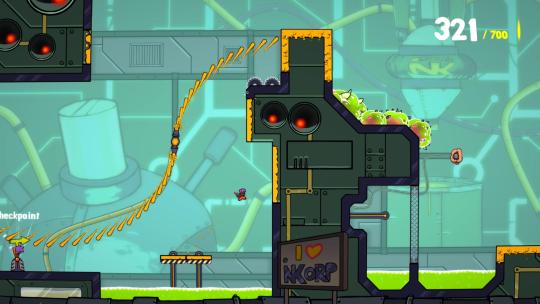
11. Why do you like platformers?
First of all Super Mario Bros has a lot to do with it because it’s the very first video game I played when I was a kid. Mario isn’t the only one of course, and we all have been rose with platformers in the 80/90s. Especially me :D.
Then I think platformers are quite interesting on the level design side, because with a very few and simple mechanics you can have an action game that is both easy to learn and quite rich in terms of challenges and diversity.
Personally as a player I’m more often onto action games, with fast real time interactions, rather than slow-paced games that makes you stop every 30 seconds to solve long puzzles for instance. And among these arcade/action games, platformers have this advantage to basically use all the screen space. They bring a cool “curvy” sense of height to the gameplay by using the gravity in many different ways. So this mix between cool navigation, awesome level design, and all of that wrapped in a fancy universe with charismatic characters, are the reasons why I feel good playing this type of games. I mean … the good platformers.
12. One last question… can you tell us anything about your next project?
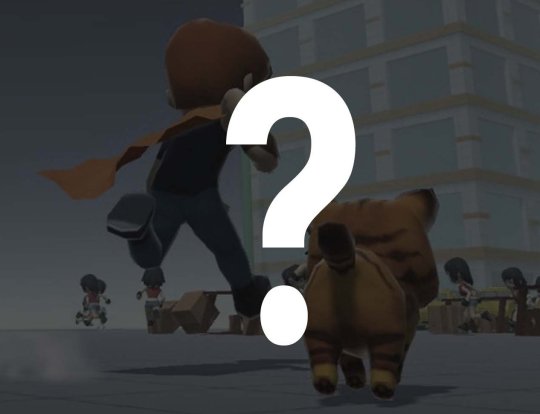
In case you are interested in Romain’s upcoming game (a 3D beat ‘em all / platformer) consider to check out his twitter (@clauclaudr) where he started to post about it.

(Games on which Romain Claude has worked on: Rabbids Go Home, Rayman Origins, Rayman Legends, Seasons After Fall, Splasher, Untitled Upcoming Game)
Splasher information:
Release: Sep 2017 (Switch, PS4, XB1) | Feb 2017 (PC)
Genre: Precision Platformer with Paintgun Mechanics
Number of Players: 1
Developer: Splashteam
Publisher: Playdius
Development Time: 4 years
Development Team: 5
Website:splasher-game.com

